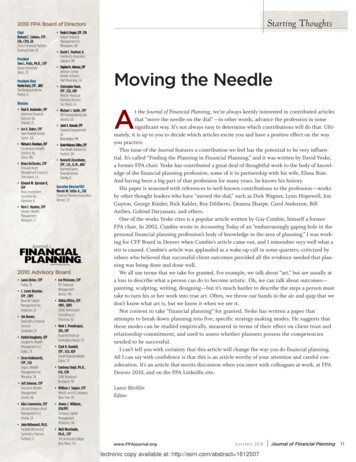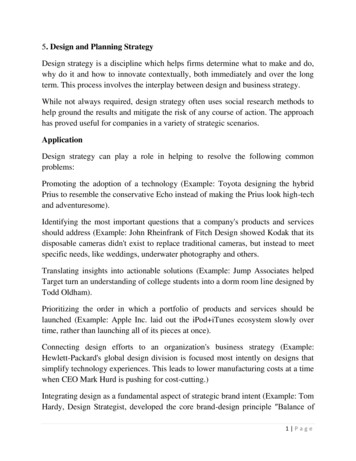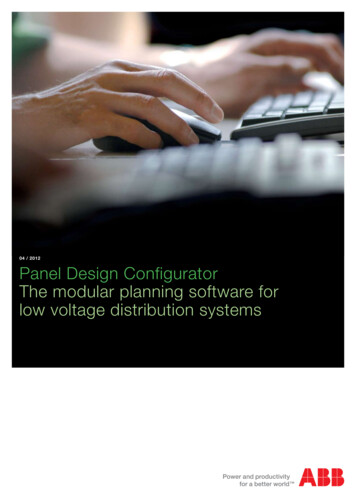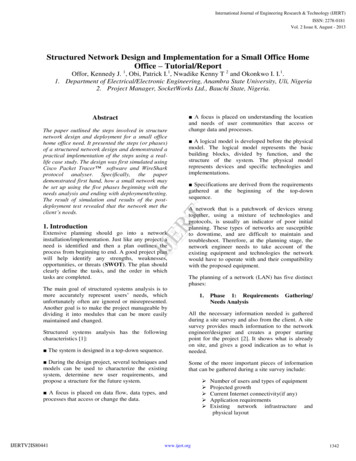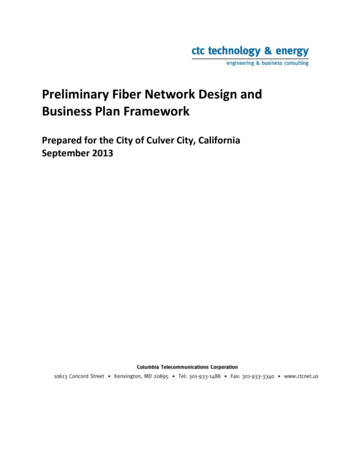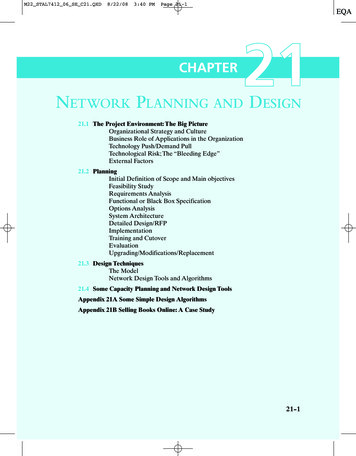
Transcription
M22 STAL7412 06 SE C21.QXD8/22/083:40 PMPage 21-1CHAPTERNETWORK PLANNING AND DESIGN21.1 The Project Environment: The Big PictureOrganizational Strategy and CultureBusiness Role of Applications in the OrganizationTechnology Push/Demand PullTechnological Risk; The “Bleeding Edge”External Factors21.2 PlanningInitial Definition of Scope and Main objectivesFeasibility StudyRequirements AnalysisFunctional or Black Box SpecificationOptions AnalysisSystem ArchitectureDetailed Design/RFPImplementationTraining and nt21.3 Design TechniquesThe ModelNetwork Design Tools and Algorithms21.4 Some Capacity Planning and Network Design ToolsAppendix 21A Some Simple Design AlgorithmsAppendix 21B Selling Books Online: A Case Study21-1
M22 STAL7412 06 SE C21.QXD21-28/22/083:40 PMPage 21-2CHAPTER 21 / NETWORK PLANNING AND DESIGNThe business user of data communications most often applies the technical material in this book to the planning and design of a data communications system, orto the operation and management of such a system. In this chapter, we deal withplanning and design of data communication systems. We look first in at the largerissues of how the organizational strategy, culture, and policies affect the planningand designing of data communication systems. Next, we look at systematic methods for planning and design. Section 21.3 is an overview of design algorithms andtools. Appendix 21.A gives some of the more straightforward of the quantitativedesign techniques. Finally, Appendix 21.B is a case study of online book sales.Planning and designing of data communication networks is immensely complex. We narrow the scope considerably. First, we limit ourselves to planning and designing medium size networks. These are most frequently owned by organizationsfor their own use; that is, private networks. This excludes the very large networks,especially those public networks implemented by communication service vendorssuch as the telephone companies, and the large Internet service providers. On theother end, we do not consider networks that are so small that they can be purchased“out of the box” and for which the planning, design, and implementation can all becarried out by a very few people, perhaps only one. We focus mainly on the networkplanning and design problems of user organizations with significant coordinationissues; this usually means wide area networks. However, even those who work forcommon carriers and other communication service providers will find much of thematerial useful and certainly insight into the user (customer) perspective on theseissues is valuable. With this reduction in scope, we are still left with much to consider. We give an overview of the most important aspects.21.1 THE PROJECT ENVIRONMENT:THE BIG PICTUREBefore a data communications project even gets to the formal feasibility studies thatare part of the development methodology that we propose in this section, it is usefulto make a top-down, qualitative evaluation of a proposed data communications system. Such an evaluation need not take much time or resources and may result instopping unwise ventures early. This evaluation should start from a clear understanding of the structure, policies, and culture of the organization or organizations that willbe using the system. The business role of the proposed application must also beclearly understood. For example, one should be sure that the project is not implemented just because some advanced or new technology seems interesting. On theother hand, one must be careful that focusing too narrowly on the business need doesnot unnecessarily limit or misdirect the technical approach. Since data communications projects take place in an environment of rapid technological advancement, it isimportant to closely examine technological risk. Finally, external factors such as government policy and regulation, the competitive situation, and available technologicalservices and products must be considered. We now consider these in order.Organizational Strategy and CultureIdeally, any data communications project should be planned in the context of anorganizational information strategy and policy. Formal and informal policies regarding
M22 STAL7412 06 SE C21.QXD8/22/083:40 PMPage 21-321.1 / THE PROJECT ENVIRONMENT: THE BIG PICTURE21-3outsourcing, turnkey procurement, buying of services, and in-house developmentare important. Sometimes policies affect the use of public versus private networks.The amount of human and technical resources in the data communication functionsof the organization also strongly affects these choices. Developing a sensitive awareness of the organizational culture going into a project will help avoid later grief. Forexample, it is very important to know where your organization is on the centralized/decentralized management continuum. Usually, but not always, management ofan organization’s network will be centralized or decentralized according to whetherthe general management structure is centralized or decentralized.Unfortunately, electronic communication is so ubiquitous in modern businessthat it is hard to develop an overall strategic vision that is comprehensive and at thesame detailed enough to be useful. But a modest effort can yield a strategy to guidethe development.At this point you need to understand who are you connecting with the system,what the users are going to communicate, and what resources your organizationhas—financial, human, and time—to implement the project.Business Role of Applications in the OrganizationWhen deciding on a data communication project, there can be two types of mistakes:attempting a project that is not justified, and not implementing a project that isnecessary and/or valuable. You can often avoid these mistakes by asking yourself,What happens if the project fails, and then, what happens if the project succeeds? Ifthe success of the project would not make a substantial positive difference in yourorganization’s activities, then the project may need rethinking. Perhaps a more aggressive approach is needed to make the project offer clear advantages. On theother hand, if there are significant and unfortunate consequences of not doing theproject, or if major opportunities will be lost, then not only should the project goahead, but a conservative path should be taken in its development to make successmore likely. In any case, it is important to recognize whether the application is seenas a requirement of doing business or as an opportunity for the organization. Theseinitial evaluations do not substitute for, and should be followed by more formal return on investment, or cost benefit analyses. But, it should not take numerical evaluations of several significant figures in financial models or the successful applicationof extreme and risky technological approaches.Technology Push/Demand PullThe impetus to implement technologically oriented projects—which most data communications projects are—is often characterized as pushed by technology, or pulledby demand. In the first case, the availability of new technology with major new capability leads to an evaluation of whether the technology can be used profitably withinthe organization. That is, a consideration of the technology precedes the determination of the business application. Demand-pull represents the situation where theplanners start with a business need and look for the appropriate technology to satisfy it. A good example of both is e-commerce. Few traditional organizations thatwere early users of the technology felt a requirement to do business electronically.Rather, they saw the availability of the technology that might reduce costs andexpand markets.This is an example of technology push. Later, as electronic businesses
M22 STAL7412 06 SE C21.QXD21-48/22/083:40 PMPage 21-4CHAPTER 21 / NETWORK PLANNING AND DESIGNbecame significant, electronic commerce became a competitive requirement. For anexample, see the Case: “Selling books, . online” in Appendix 21B.Technological Risk; The “Bleeding Edge”The aggressiveness in which new technology is used in projects can strongly affectthe chances of project success. If you are too aggressive in using new technologiesbefore they are well proven, the technologies may not be available when advertised,or they may not work as advertised. This can delay the project, prevent it from meeting its specifications, or, ultimately, make the project fail. On the other hand, tootimid a use of technology can make the project obsolete the day it is completed.External FactorsThe many external factors affecting your project should not be neglected. These include government(s) regulation, activities of your competitors, and the current andprojected availability of technology.21.2 PLANNINGIt is important to have a formal planning procedure for any nontrivial project. Thereare many project-planning methodologies; however, most are similar. Many organizations have their own, “blessed” versions, but the mapping from the methodologywe suggest here to other methodologies should be reasonably straightforward. It issometimes argued that most projects involve modifications of existing systems, andtherefore formal system planning is too time consuming and offers meager benefits.This argument is often false in the premise and/or the conclusion. The exponentialgrowth of Web-based communications, particularly e-commerce, using the Internetcalls for new networks or radical redesign of existing networks, not an evolutionarychange from previous networks. But even if the proposed project is a seeminglystraightforward enhancement to existing systems, a sequence of incrementalchanges without a well-thought-out strategy guiding the development results inbaroque networks that are opaque to the user and difficult to manage.All the methodologies consist of a number of stages to be performed in theproject development process. Whatever the methodology, it is essential that at theend of each stage management make an explicit and written decision whether toabort the project, proceed to the next stage, or go back to previous stage and resolvespecifically defined issues. One typical methodology is outlined in Table 21.1 anddiscussed in what follows.Initial Definition of Scope and Main objectivesAt the start of a project, you will often be given an informal characterization of thetask at hand—sometimes very informal. A crisp, unambiguous, written characterization is necessary at this point. This description should summarize the results of thekind of strategic, high-level analysis described at the beginning of the previous section.Some of the issues to be addressed are,Who is communicating with whom? Is the project designed to support communications within the company, communications with
M22 STAL7412 06 SE C21.QXD8/22/083:40 PMPage 21-521.2 / PLANNING21-5Table 21.1 Steps of a Development Methodology1. Initial Definition of Scope and Main Objectives2. Feasibility Study3. Requirements Analysis4. Functional or Black Box Specification5. Options Analysis6. System Architecture7. Detailed Design/RFP8. Implementation9. Training and Cutover10. Evaluation11. Upgrading/Replacementvendors and customers (business-to-business), communications with customers(retail), or a combination of these? What is to be communicated? What business functions will the proposed network support? What, in general terms, is the business rationale for the project? What is the time frame for the proposed project? Who is on thenet; who is off; what classes of services are to be provided?Feasibility StudyThe feasibility study for a project is very important because it is usually the last opportunity to make major changes in the project before substantial resources areexpended. At this point quantitative cost/benefit analyses are required to make surethat the project has a high expectation of success. Part of the feasibility study is tomake sure that the budget and time allowance is sufficient for the objectives specified in the initial definition step. The feasibility study will be based on assumptionsthat must be made explicit, in writing. If, during the project, one or more of these assumptions becomes invalid, an immediate assessment of the project should be madeto see if adjustments are needed to maintain feasibility. Another appraisal needed atthis point is of technological risk. Choosing exactly which generation of technologyto use is fundamental. Unfortunately, appropriate technology is a moving target. Formost projects, available technology will improve significantly in the period of implementation. One popular indicator of the exponential growth of computer technology is Moore’s law, which, in one of its manifestations, tells us that the performanceof computer chips as measured by the number of transistors doubles every 18months. In any case, a project, especially a slowly developing one, will find technology growing under its feet.Requirements AnalysisThe objective here is to refine and make quantitatively explicit the objectives ofStep 1. This starts with specifying the explicit services to be provided (see Chapter 2),such as voice, data, Web services, e-commerce, and various types of multimedia. Tothe extent possible, future services must be provided for as well.
M22 STAL7412 06 SE C21.QXD21-68/22/083:40 PMPage 21-6CHAPTER 21 / NETWORK PLANNING AND DESIGNFor each service, one must quantify current traffic and project this traffic intothe future. Particularly difficult is traffic modeling for new or projected services forwhich there is no current traffic to use as a baseline. The least likely traffic for sucha network is what you projected. Either the network fails and you get less traffic,perhaps none, or the network/application succeeds, in which case you must takerapid steps to prevent being overwhelmed. Quality of service (see Chapter 8) is alsoan important issue in modern requirements analysis. Diffe
21-4 CHAPTER 21 / NETWORK PLANNING AND DESIGN became significant,electronic commerce became a competitive requirement.For an example, see the Case:“Selling books, . online” in Appendix 21B. Technological Risk;The “Bleeding Edge” The aggressiveness in which new technology is used in projects can strongly affect the chances of project success. If you are too aggressive in using new


